The Adult Food Pyramid: A Practical Guide You’ll Actually Use
A friendly, practical roadmap to the adult food pyramid — what to eat, how much, and how to make it work in real life (no guilt, no spreadsheets).
If you’re trying to eat better without becoming a walking label scanner, welcome. The adult food pyramid is a simple visual that keeps meals sane: more plants, sensible grains, steady protein, and treats that don’t hijack your week.
I’m not here to moralize — I once ate cereal out of spite at midnight — but I will give you a structure that makes everyday choices easier.
Why the adult food pyramid actually helps (and won’t ruin your life)
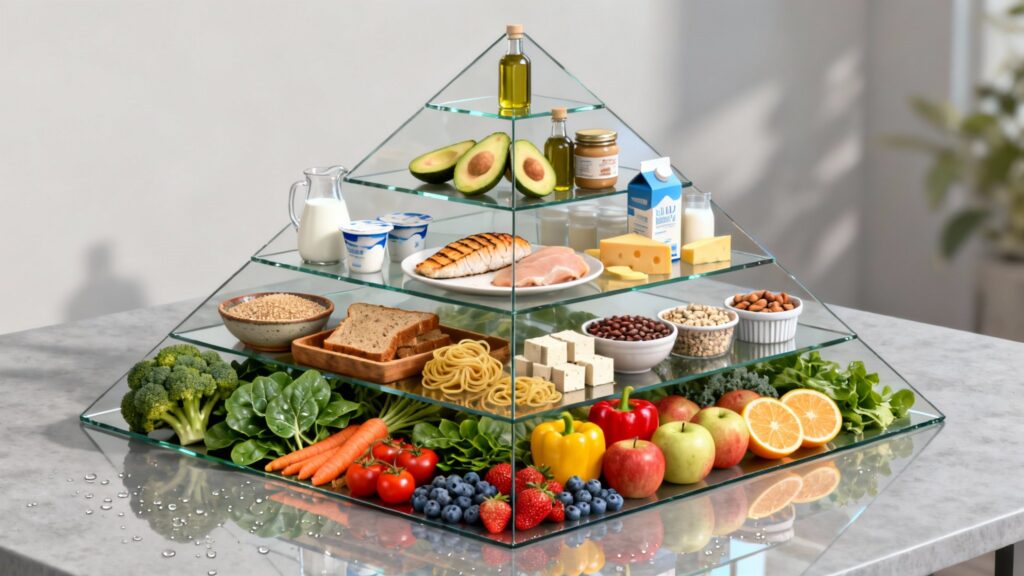
We all want easy rules that work. The adult food pyramid gives you one: stack your plate in a way that supports energy, keeps you full, and doesn’t require you to become a meal-prep influencer.
The adult food pyramid isn’t some strict rulebook — it’s more like a gentle nudge in the right direction. It reminds you to reach for the foods that actually do something for you — the ones packed with fiber, minerals, and that kind of steady, lasting fullness that doesn’t crash an hour later.
But here’s the best part: it’s not anti-fun. There’s still room for the good stuff — pizza nights, birthday cake, that “I earned this” scoop of ice cream after a long day. Because a healthy life should actually feel like living, not surviving on kale and regret.
If the food pyramid were a person, it would be that kind of friend who would go into the grocery lane with a shopping list at hand – a list not that has both the greens and treats without the guilt feeling while making it. Supportive, not strict.
I still laugh thinking about a grocery run with my sister at Costco. She reminded me — very seriously — not to forget all the veggies we needed for the week… then immediately handed me a chocolate bar and said, “You have to try this.” Balance, right?
So the food groups in the pyramid are actually there as a guide to achieve a balanced diet and a healthy diet in one go.
How the Pyramid Maps to a Plate (The Short, Useful Version)
Here’s your quick food guide pyramid on a plate:
Base: Vegetables, fruits, and whole grains — they’re your foundation, the stuff that fuels you through real life.
Middle: Lean proteins and dairy (or fortified plant options) — the steady layer that keeps you full and satisfied.
Top: A small sprinkle of fats, sweets, and ultra-processed extras — not banned, just enjoyed on purpose.
Modern guides like USDA’s MyPlate and Harvard’s Healthy Eating Plate back this up: fill half your plate with produce, one quarter with whole grains, one quarter with protein, and add a bit of healthy fat for good measure.
It’s balanced, flexible, and realistic — the kind of plan you can actually stick with instead of swear off. The adult food pyramid is just a user-friendly translation of that. Use it as your visual cheat sheet.
The Foundation: Load the Base with Whole Grains and Vegetables
Here’s where the magic happens: make most of your meal vegetables, fruits, and whole grains. Do this consistently and you’ll notice fewer energy dips, smaller snack cravings, and less food remorse.
Why it works
Steady energy: You don’t collapse at 3 PM. Why? Because whole grains release glucose slowly.
Nutrient density: Veggies and fruit bring vitamins, minerals, fiber, and antioxidants.
Natural satiety: Fiber makes you feel full without complicated measuring.
I used to think this meant endless salads. It doesn’t. It means building meals around color and fiber, then letting proteins and fats support the plan.
Whole grain swaps that stick
Start simple. Mix brown and white rice. Swap overnight oats for sugary cereal. Use legume or whole-wheat pasta. Add barley or farro to soups.
Quick portion cue: a cupped palm of cooked grains per serving is usually enough.
Vegetables: make them actually craveable
Frozen veg? Totally fine. Canned tomatoes? Weeknight hero. Roast a tray of mixed veggies on Sunday and suddenly you have lunch-ready sides all week.
My personal trick: roast with a little olive oil, salt, and garlic — a little char does wonders.
Proteins: Steady, Not Showy
Protein is the part of the meal that keeps you focused and satisfied. You don’t need a giant steak; you need the right amount most of the time. And I’m talking about the real, fresh ones – avoid processed meats if you can.
Everyday protein hits
- Fish, poultry, eggs
- Beans, lentils, tofu, tempeh
- Nuts and seeds
Portion cue: a deck-of-cards size for meat/fish, about a cup for cooked beans. Aim for protein with every meal — it helps curb late-afternoon vending-machine cravings.
In my house, putting Greek yogurt or eggs in breakfast meant fewer “I-don’t-care” snack moments by 3 PM.
A quick science-backed nod
Research on dietary patterns, including trials like the Mediterranean-style PREDIMED study, shows heart benefits when diets emphasize plant foods and healthier fats (olive oil, nuts) along with moderate fish intake. That aligns well with the adult food pyramid’s focus.
Dairy and Its Flexible Role in the Adult Food Pyramid
Dairy’s a handy little package — calcium and vitamin D all in one go — but it’s not a dealbreaker if you skip it.
If your body and dairy get along, go for low-fat milk, plain yogurt, or a little cheese here and there. They’re simple, nutrient-packed dairy product options that fit nicely into the adult food pyramid.
If dairy and you aren’t exactly best friends, no worries. Unsweetened, fortified plant milks and yogurts do the job just as well. Just keep an eye on labels so you can still stay healthy — some “healthy” plant milks sneak in more sugar than a dessert bar.
In my kitchen, a few simple swaps honestly changed the game. Instead of those sugary, “flavored” yogurt cups (that are basically dessert in disguise), I go for plain yogurt with fresh fruit and a handful of nuts. It’s creamy, crunchy, naturally sweet —just the right balance and doesn’t make me crash by 10 a.m.
For smoothies, I use unsweetened fortified oat milk. It’s rich and neutral, blends like a dream, and doesn’t secretly dump a pile of sugar into my breakfast. Little changes like that? They add up fast.
Fats, Oils, and Treats: Small Amounts, Big Difference
Let’s talk about fat — yep, the good kind. The one that makes food taste incredible, keeps you from raiding the pantry an hour later, and helps your body soak up all those important vitamins. Somewhere along the way, fat got stuck with a bad reputation, but honestly? It’s not the villain. It’s the quiet hero in the background, holding the whole meal together.
In the adult food pyramid, healthy fats don’t need the spotlight — they steal it anyway. A drizzle of olive oil over roasted veggies, a few slices of avocado melting onto warm toast, a small handful of nuts when you need a quick snack — they all add that little something that makes your food feel complete. Even a sprinkle of seeds on a salad can turn “eh” into “oh wow.” Tiny tweaks, big payoff — and zero guilt required.
The Friendly Fats
- Extra-virgin olive oil
- Avocado
- Nuts and seeds
- Fatty fish like salmon and sardines
Use less of: butter and heavily processed oils (okay sometimes).
Avoid: trans fats (“partially hydrogenated” on labels).
Treats: plan them, don’t panic

Treats are part of life. The trick is to enjoy them intentionally. Enjoy eating it and don’t think about feeling guilty for eating. But if you can’t keep the guilt off from coming into your head, I’ll give you this little trick: pair your sweets with some protein or healthy fat. A dark chocolate with almonds is still good or maybe you prefer to grab a fruit with a spoonful of peanut butter to go with it. It keeps your blood sugar (and your mood) a whole lot steadier, without guilt-tripping.
How to Build a Balanced Plate with All the Food Groups Without Overthinking It
Nope, you don’t need to have a measuring cup beside your plate every meal. Just use your eyes.
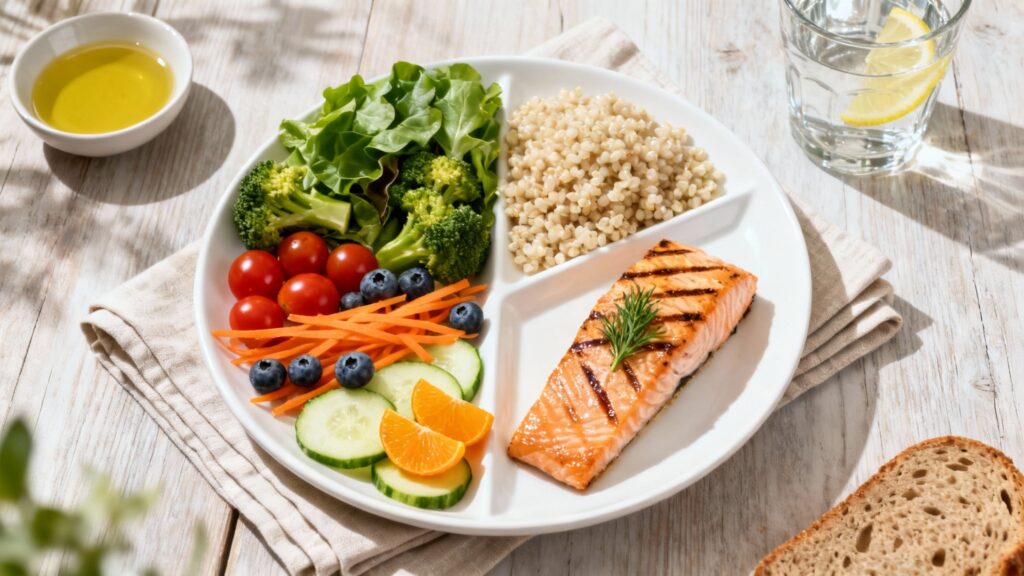
I normally fill half of my plate with veggies and fruit – ah, love those colors! They just bring additional appetite right then and there. I would also grab whole grains or starches to cover a quarte of my plate. And meat! Not to forget those juicy and tender proteins on the table – a quarter of that and finish it with a touch of healthy fat. That’s it. Simple, flexible, and no fuzz. Best part? It works whether I’m at home cooking my own meals or staring down a restaurant menu with friends.
That’s it. No weighing, no endless calorie math.
Here are some addition tips:
- At restaurants, pick veggie sides first.
- At buffets, start with the salad and return only once for the main.
Quick, Real-Life Meals You’ll Actually Make
Let’s be honest — nobody wants to spend three hours “meal-prepping” on a Sunday unless they’re being paid for it. These adult food pyramid–friendly meals are quick, forgiving, and totally doable, even when you’re tired and tempted to order takeout.
Fast, balanced favorites
- Oats with chia, peanut butter, banana, and cinnamon – Cozy breakfast that keeps you full till lunch.
- Sheet-pan salmon with roasted broccoli and farro – Toss everything on one pan, bake, and boom — dinner with minimal cleanup.
- Brown rice bowl with black beans, sautéed peppers, avocado, and salsa – A 10-minute fix that hits every food group.
- Whole wheat pasta with spinach, cherry tomatoes, cannellini beans, and parmesan – Comfort food with fiber; your 6 PM self will thank you.
- Farro salad with arugula, roasted carrots, chickpeas, and feta – The kind of “salad” that eats like a meal, not a side dish.
Here’s my personal ritual: I batch-roast veggies and cook a big pot of grains on Sunday. It doesn’t make me a Pinterest mom or a nutrition saint — but it does make weeknights way less chaotic. Future-me is always grateful.
Shopping and Kitchen Shortcuts That Save Your Sanity
Healthy eating doesn’t have to look like a cooking show. The adult food pyramid works even if you’re allergic to complicated recipes.
Try these simple moves:
- Mix fresh and frozen produce. Frozen veggies are a lifesaver — same nutrients, less guilt when life gets busy.
- Buy grains in bulk. Cook once, eat twice (or three times). Future lunches = handled.
- Use canned beans. Rinse and they’re ready for salads, soups, or tacos. Fast, cheap protein.
- Keep lemons, garlic, and herbs nearby. A little squeeze or sprinkle turns “meh” into “wow.”
And if you hate cooking, you’re still covered. Seriously — microwaveable brown rice, frozen fish, and a bag of spinach can turn into a real dinner in ten minutes. The adult food pyramid isn’t about perfection; it’s about practicality.
Movement: The Multiplier
Food sets the foundation, but movement brings it to life. I used to beat myself up for not cranking out hour-long workouts. Now, I keep it simple — a 20-minute walk, a few bodyweight moves, and I’m done. No guilt, no overthinking. Just a little movement that actually fits into real life — and honestly, that’s what sticks. My mood’s better, my sleep’s smoother, and my meals naturally line up with that “take care of yourself” energy the adult food pyramid is built on.
Common Pitfalls in Trying “Healthy Eating” and Easy Fixes
Even with the best intentions, life happens. The trick is knowing how to pivot instead of quit.
Pitfall #1: Veggies that die in the crisper
Fix: Keep frozen veggies on standby and roast fresh ones the day you shop. They’ll last longer, taste better, and your fridge will look less like a veggie graveyard.
Pitfall #2: “Whole grain” imposters on labels
Fix: Read the fine print. The first ingredient should be “whole” something (like whole wheat or whole oats). Bonus points for 3+ grams of fiber per serving.
Pitfall #3: The dreaded boring salad
Fix: Add life — toss in nuts, seeds, a grain like quinoa, and a dressing that’s more than sadness and vinegar. My go-to? Olive oil, lemon juice, and a little salt. Works every time.
How Much Should You Eat? Simple Portion Cues
- Protein: Deck of cards
- Grains/starchy carbs: Cupped palm
- Fats (oil or nut butter): Thumb size
- Veggies: Two open hands
These cues keep the adult food pyramid practical — measurable without measuring utensils.
A Note on Research and the Bigger Picture
Nutrition science evolves, but consistent patterns hold up:
Diets higher in vegetables, whole grains, legumes, nuts, and fish — and lower in ultra-processed foods — tend to support long-term health.
The adult food pyramid maps to this evidence by promoting mostly whole foods and sensible portions.
If you want a deeper dive, reputable sources like Harvard’s School of Public Health and national dietary guidelines are great reference points.
Meal Planning Without the Pressure
Make a loose plan: roast veggies, cook a grain, prepare a protein, and you’ve got three dinners waiting.
Keep a simple rotation of breakfasts you enjoy (oats, eggs, yogurt bowls). That predictability makes the adult food pyramid a habit, not a chore.
What to Do When Life Gets in the Way
Traveling? Busy week? Hungry kids? The pyramid flexes. Choose the best available option — pick the veggie-heavy side, order grilled protein, skip extra sugary drinks. Treats are allowed. Perfection is not.
When I travel, my rule is: eat vegetables at two meals a day and make one meal intentionally good. That mindset keeps the adult food pyramid working without taking over my trip.
Short FAQ (Because You’ll Ask)
Q: How many fruits and vegetables per day?
A: Aim for at least five portions. Think color variety.
Q: Can I still eat red meat?
A: Yes — occasionally. Favor fish, poultry, beans, and plant proteins more often.
Q: Do fats make you fat?
A: No. Quality and quantity matter. Choose healthy fats and watch portions.
Q: How does exercise fit?
A: Aim for ~150 minutes of moderate activity weekly. Walks count.
Q: What about dairy-free diets?
A: Use fortified plant milks and get calcium from tofu, leafy greens, and canned fish with bones.
Final Takeaway: Start with Small, Repeatable Moves
The adult food pyramid is a tool, not a test.
Build meals around vegetables and whole grains, add steady protein, use healthy fats for satisfaction, and keep treats intentional. Move a bit each day. Repeat most days. That’s the whole strategy.
If you try one thing: make breakfast a protein-first meal. You’ll notice how much easier the rest of your day becomes. I did — and it made a difference that lasted longer than any “detox” ever did.

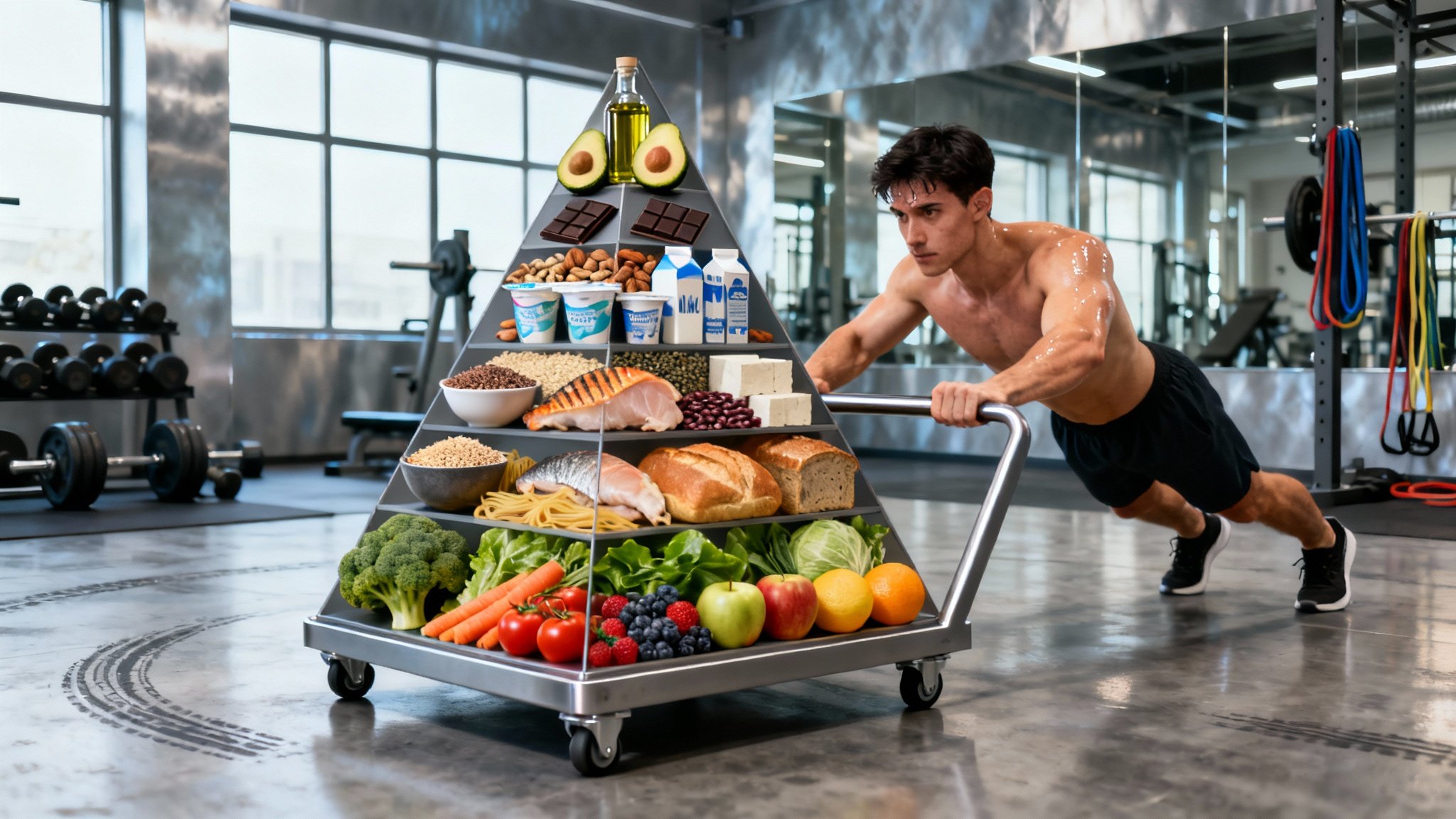
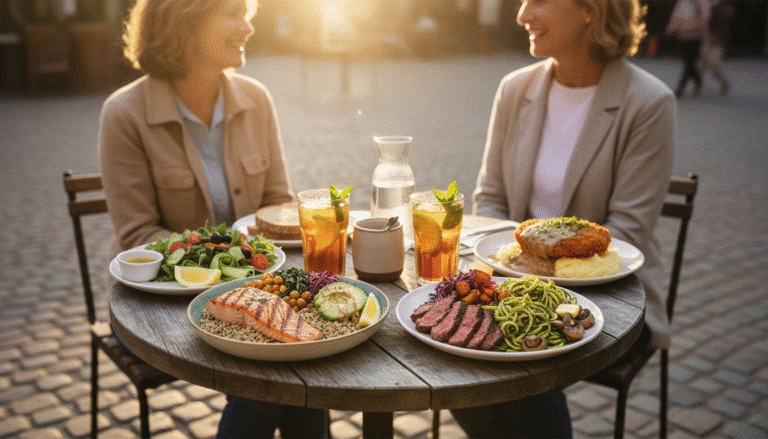

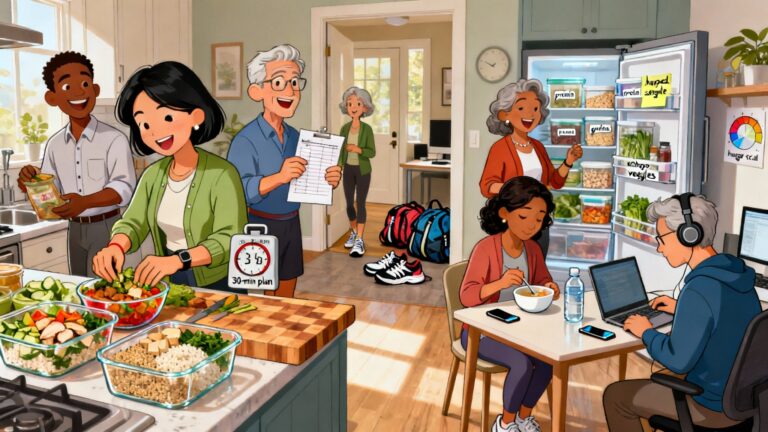
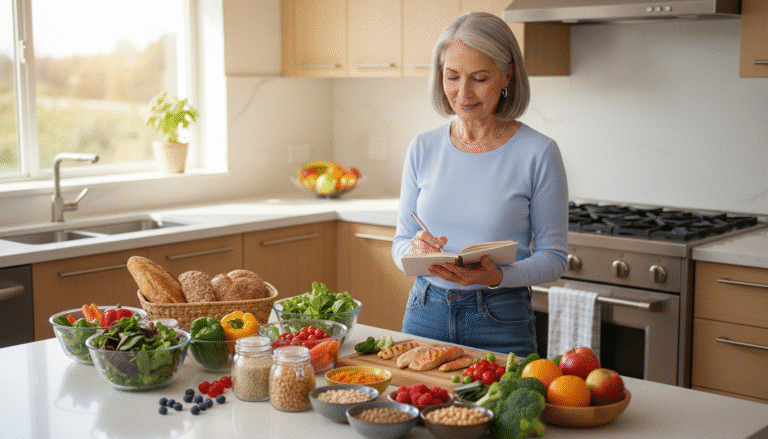
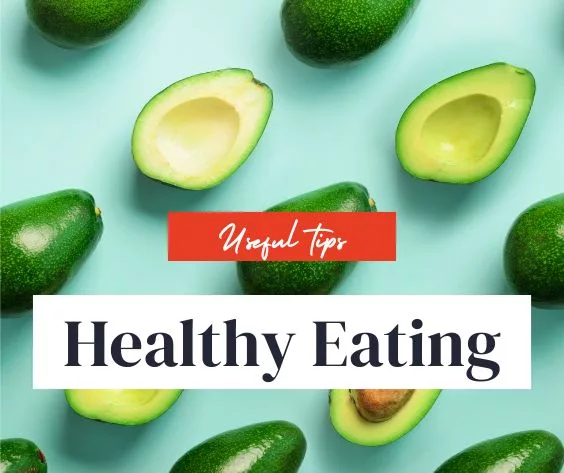
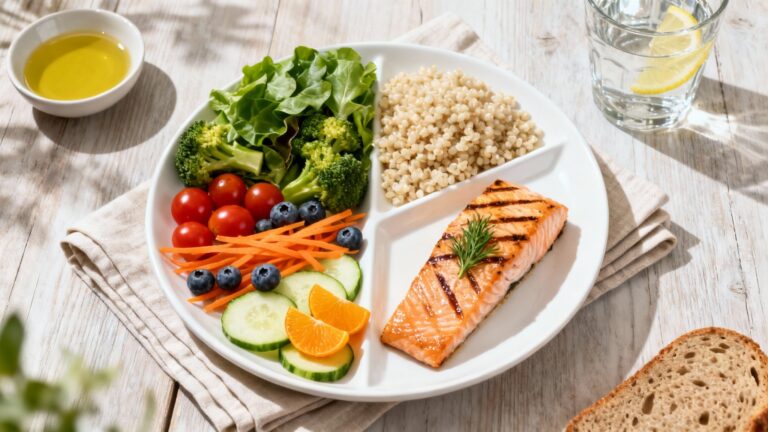
One Comment
Comments are closed.